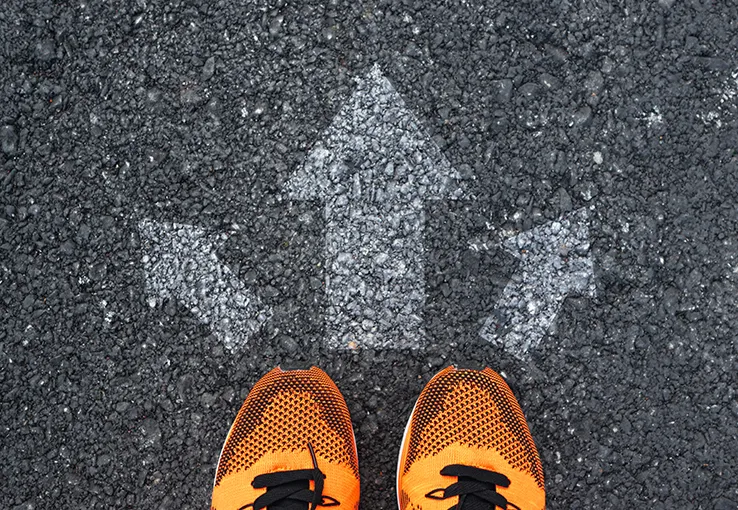How to create a journey map
First, you need some background
A journey map is a visualization tool that helps organizations identify and understand the experiences their customers are having and find ways to improve them. Before beginning the journey map, we need to understand the current state of the company. Consider where you are now, what you know about your processes, and what hypotheses you already have in order to set the foundation for your research.
Begin with the end in mind
Equally as important as understanding where you are is determining where you want to be, or your goal state. What does success look like? Who will use the map? What does streamlining the journey mean for the business as a whole? Knowing what you aim to get out of a journey map helps guide what research methods to use.
Once you determine where you are and where you want to be, you can begin designing creative and efficient solutions to get you from one to the other.
Gathering information
To understand what your customers experience, you have to ask them. The information that informs a journey map can be gathered in a number of ways, but it will very rarely only require one method or approach. Whether using a traditional approach like focus groups or a more digitally disruptive method like webpage heatmapping, you want to make sure you’ve done thorough research on what people are experiencing with your brand. This often means using a combination of research methods.
Traditional research methods
-
Audits & observation

-
Stakeholder interviews
-
Focus groups
-
Secret shops
-
In-depth interviews (IDI)
-
Ethnographies
Digital research methods
-
Digital IDI’s

-
Surf-alongs
-
Video focus groups
-
Live chats
-
Mass collaboration chats
-
Focus forums
-
Digital diaries
-
Web traffic flow analysis
-
Webpage heatmapping
These methods can help you learn more about who exactly your customers are, if you haven’t already determined your customer personas. The information gathered is also used to outline all of the touchpoints, channels, actions, and emotions that your customers are actually experiencing, ultimately revealing pain points and opportunities.
It’s your customer’s journey — so think like it
What are your customers trying to accomplish? What are their goals?
The idea behind a customer journey map is that it tells the story from a specific customer’s point of view. That means you need to identify which customer, or persona, is the subject of the journey map. Different personas could very well have different experiences when trying to do the same thing, so you need to clarify which experience you are mapping. It can be tempting to merge personas or view the experience from the organization’s lens, but you want to stay in your persona’s point of view.
Walking the customer’s journey
When you begin thinking about your customer’s goals, you can work backwards to determine the journey triggers, or the start of the journey map. A trigger is what kicks the story off; what has led this customer to turn to you in the first place? You want to consider all of the reasons this person might buy your product or service. One trigger could have the potential to set customers off on multiple different paths, or simply one. Multiple triggers could have their own paths, or all lead to the same path.
The action that the trigger instigates and every action following it define the journey path. These actions are also known as touchpoints, or where the customer actually engages with the brand. The method they use to facilitate that engagement is the channel. If the trigger was, say, running out of coffee, there would likely be a few paths that could follow:
Example path 1: Return customer
Action/Touchpoint: Reorder the same coffee
Channels: This could take place via a phone call, the distributor’s website, an online grocery order, another third party website such as Amazon, or they could go to the store to buy in person.
Example path 2: Considering the options
Action/Touchpoint: Research to see if there are other flavors or brands they want to try or if anything is on sale
Channels: This could take place via a phone call, online searches, friends or referrals, social media or, again, they could go to the store to look at options in person.
Each action following the trigger requires the customer to weigh options and make decisions across any number of channels. The goal is to figure out what those paths are, the actions the customer takes that define the path, and the thoughts and emotions that are associated along the way.
Digitize the map
Once your goals, personas and paths are set, you can digitize the journey map to make it tangible and shareable. Whether it's a PowerPoint, PDF, or interactive map, the journey map should touch every member of your organization and keep everyone on the same page. By creating a final product that is aesthetically pleasing and in a digital form, your team has a shared vision of the experiences they are delivering.
Journey maps can take a variety of shapes and forms — what’s important is that you are doing the proper research to inform touchpoint engagements, the actions they’re taking, the channels they’re using, and how they are feeling throughout the process. If you’re not sure where to start, our research specialists are here to help.


